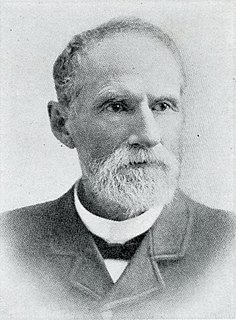
The Oregon Supreme Court (OSC) is the highest state court in the U.S. state of Oregon. The only court that may reverse or modify a decision of the Oregon Supreme Court is the Supreme Court of the United States. The OSC holds court at the Oregon Supreme Court Building in Salem, Oregon, near the capitol building on State Street. The building was finished in 1914 and also houses the state's law library, while the courtroom is also used by the Oregon Court of Appeals.

The United States District Court for the District of Oregon is the Federal district court whose jurisdiction comprises the state of Oregon. It was created in 1859 when the state was admitted to the Union. Appellate jurisdiction belongs to the United States Court of Appeals for the Ninth Circuit. Matthew P. Deady served as its first judge. Marco A. Hernandez is the current chief judge.
Same-sex marriage in Oregon has been legally recognized since May 19, 2014, when a U.S. District Court judge ruled in Geiger v. Kitzhaber that Oregon's 2004 state constitutional amendment banning same-sex marriages discriminated on the basis of sexual orientation in violation of the Equal Protection Clause of the United States Constitution. A campaign that was then under way to win voter approval of a constitutional amendment legalizing same-sex marriage was suspended following the decision. In July 2015, Governor Kate Brown signed legislation codifying same-sex marriage in various Oregon statutes. The law change went into effect on January 1, 2016.
Ballot Measure 58 was a citizen's initiative that was passed by the voters of the U.S. state of Oregon in the November 1998 General Election. The measure restored the right of adopted adults who were born in Oregon to access their original birth certificates. The measure passed with 609,268 votes in favor, 454,122 against. It was immediately challenged by several birth mothers who had put children up for adoption, which delayed instituting the measure for a year and a half.

Albin Walter Norblad Sr., was a prominent citizen of Astoria, Oregon, United States, and the 19th Governor of Oregon from 1929 to 1931.

Diarmuid Fionntain O'Scannlain is a Senior United States Circuit Judge of the United States Court of Appeals for the Ninth Circuit. His chambers are located in Portland, Oregon.

The government of the U.S. state of Oregon, as prescribed by the Oregon Constitution, is composed of three government branches: the executive, the legislative, and the judicial. These branches operate in a manner similar to that of the federal government of the United States.

Ann Louise Aiken is an American attorney and jurist in the state of Oregon. A native Oregonian, she has served as a state court judge of the Oregon circuit courts and worked in private legal practice. She is currently a United States District Judge of the United States District Court for the District of Oregon. She served as Chief Judge of the Court from February 1, 2009 to January 31, 2016.

Wallace P. Carson Jr. is an American attorney and politician from Oregon. He has spent time in both of Oregon's legislative branches and served on the Oregon Supreme Court for 24 years. Carson's fourteen-year tenure as chief justice was longer than that of any of his predecessors.
The Oregon Court of Appeals is the state intermediate appellate court in the US state of Oregon. Part of the Oregon Judicial Department, it has thirteen judges and is located in Salem. Except for death penalty cases, which are reserved to the Oregon Supreme Court, and tax court cases, it has jurisdiction to hear all civil and criminal appeals from Oregon circuit courts, and to review actions of most state administrative agencies. The 13 judges of the court are chosen by the people in statewide nonpartisan elections to six-year terms, and have as their administrative head a Chief Judge appointed from their number by the Chief Justice of the state Supreme Court.

Reuben Patrick Boise was an American attorney, judge and politician in the Oregon Territory and the early years of the state of Oregon. A native of Massachusetts, he immigrated to Oregon in 1850, where he would twice serve on the Oregon Supreme Court for a total of 16 years, with three stints as chief justice. Early in his legal career, he worked as a district attorney.

John McCourt was an American attorney and jurist in the state of Oregon. He served as the 51st Associate Justice of the Oregon Supreme Court. Prior to joining the court, McCourt had worked as United States District Attorney for the District of Oregon. A native of Canada, he was also a state court judge and member of the Oregon House of Representatives.

The Oregon Judicial Department (OJD) is the judicial branch of government of the state of Oregon in the United States. The chief executive of the branch is the Chief Justice of the Oregon Supreme Court. Oregon’s judiciary consists primarily of four different courts: the Oregon Supreme Court, the Oregon Tax Court, the Oregon Court of Appeals, and the Oregon circuit courts. Additionally, the OJD includes the Council on Court Procedures, the Oregon State Bar, Commission on Judicial Fitness and Disability, and the Public Defense Services Commission. Employees of the court are the largest non-union group among state workers.

John Hugh McNary was an American attorney and jurist in the state of Oregon. He served as a United States District Judge of the United States District Court for the District of Oregon in Portland. A native of Oregon, he also served as a district attorney and as an assistant district attorney in Salem. His brother Charles would serve as a United States Senator.
Malcolm Francis Marsh is an American attorney and jurist from the state of Oregon. He is an inactive Senior United States District Judge of the United States District Court for the District of Oregon in Portland, Oregon. A native of Oregon, he served as an active judge for eleven years, and was in private legal practice in Salem before that.
James Alger Fee was a United States Circuit Judge of the United States Court of Appeals for the Ninth Circuit and previously was a United States District Judge of the United States District Court for the District of Oregon. A veteran of the United States Army, his first judicial position was with the Oregon Circuit Court. While a federal judge he made national news for his decision during World War II regarding the application of the exclusion orders that had forced those of Japanese heritage from the West Coast.

George Greenwood Bingham was an American judge and legal educator in the state of Oregon. A native of Wisconsin, his family immigrated to Oregon in his teens, though he returned to the Midwest for his legal education. Bingham served as the second dean at the Willamette University College of Law and was also a judge for Multnomah County after previously serving as a district attorney for Salem and the state. His former home in Salem, the Dr. Luke A. Port House, is listed on the National Register of Historic Places.

The Truman Wesley Collins Legal Center houses the Willamette University College of Law at Willamette University in Salem, Oregon, United States. Located on Winter Street, just south of the Oregon State Capitol, the facility features classrooms, the law library, administrative offices, and faculty offices. The building also contains a fully functioning trial courtroom used for moot court. It houses Lady Justice, the 12-foot (3.7 m)-tall, 300-pound (140 kg) statue formerly located on the roof of the Marion County Courthouse.













